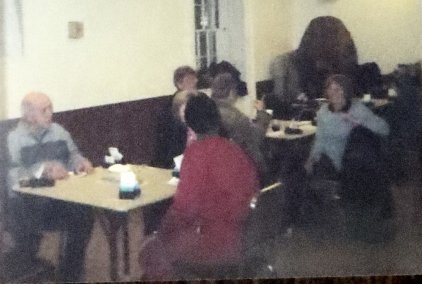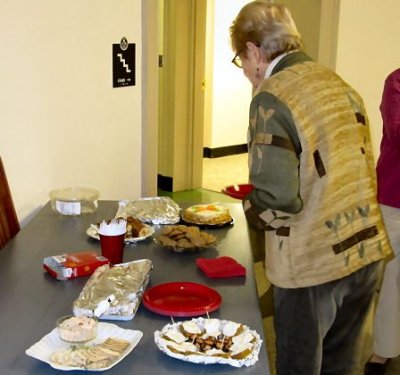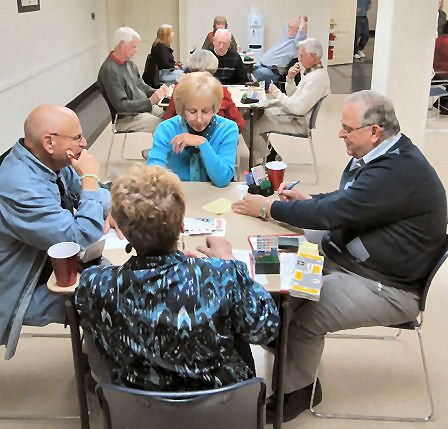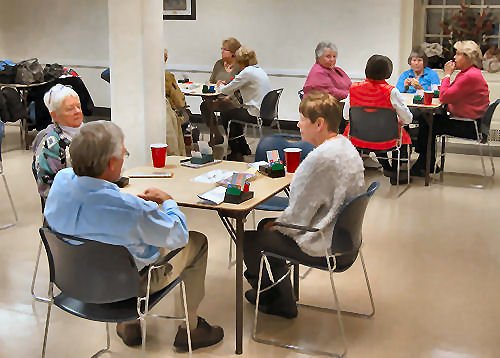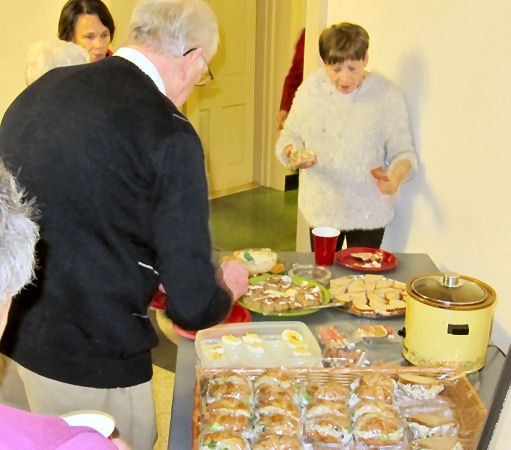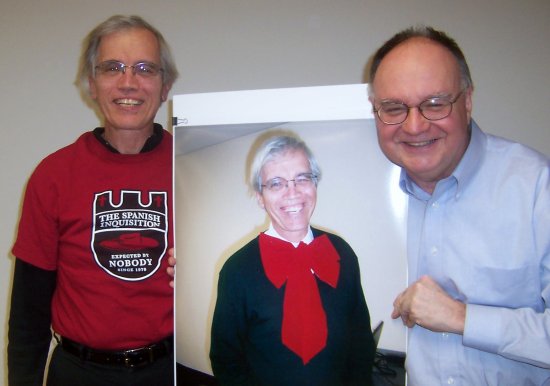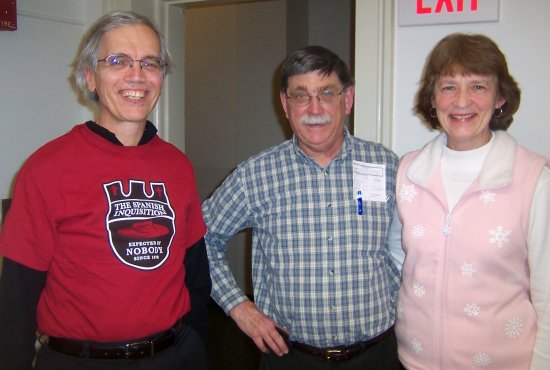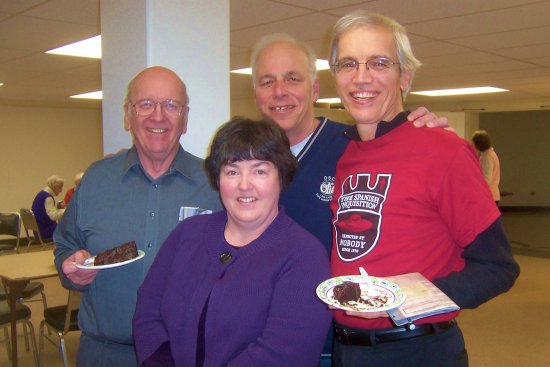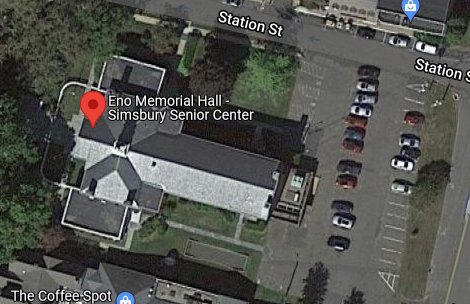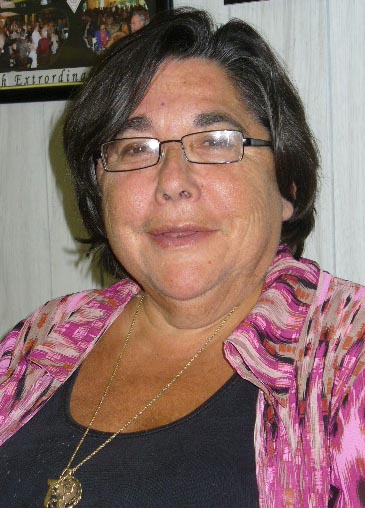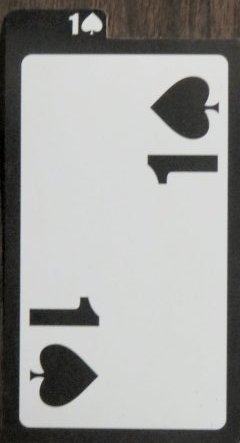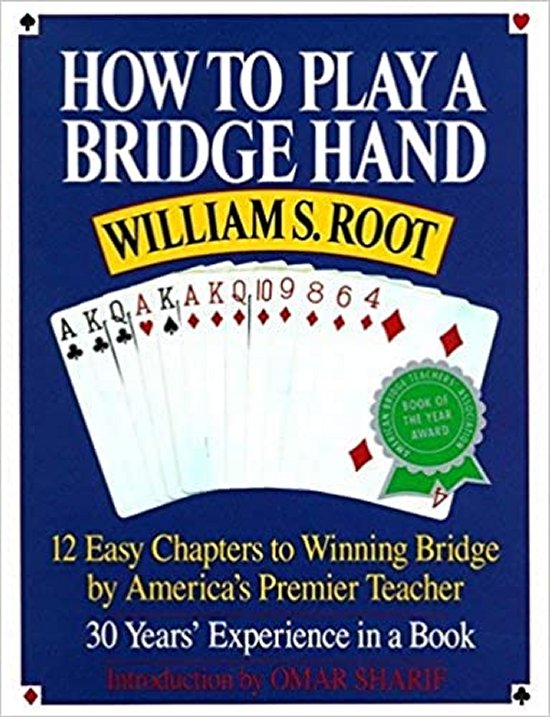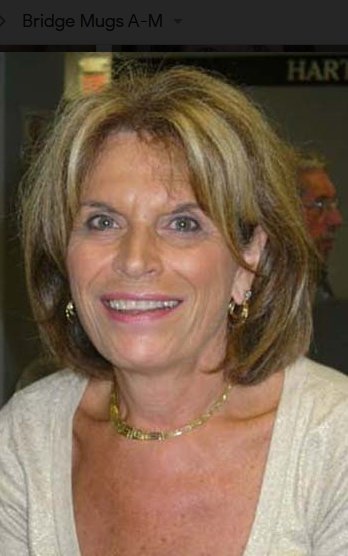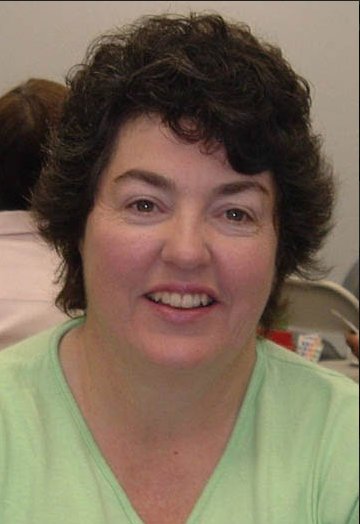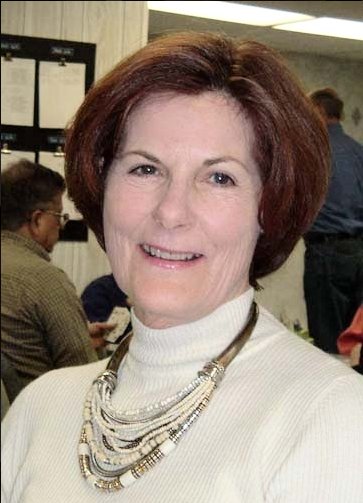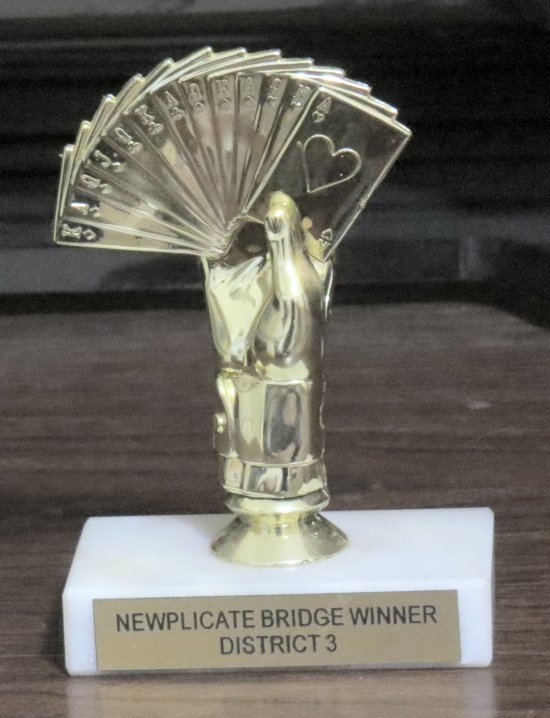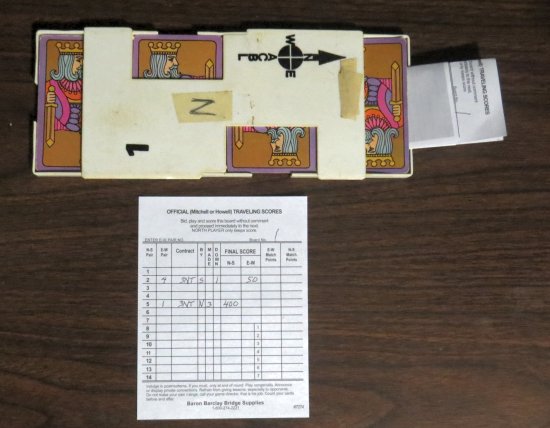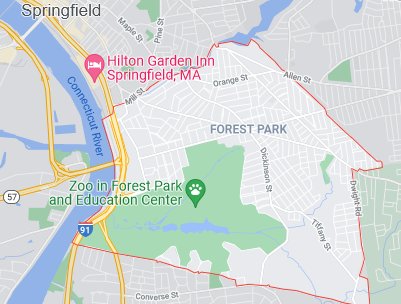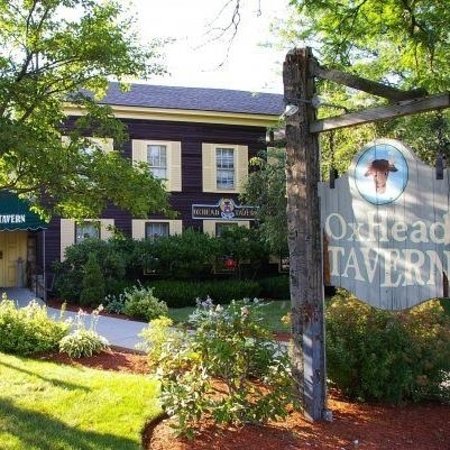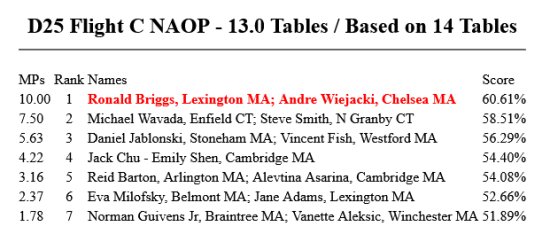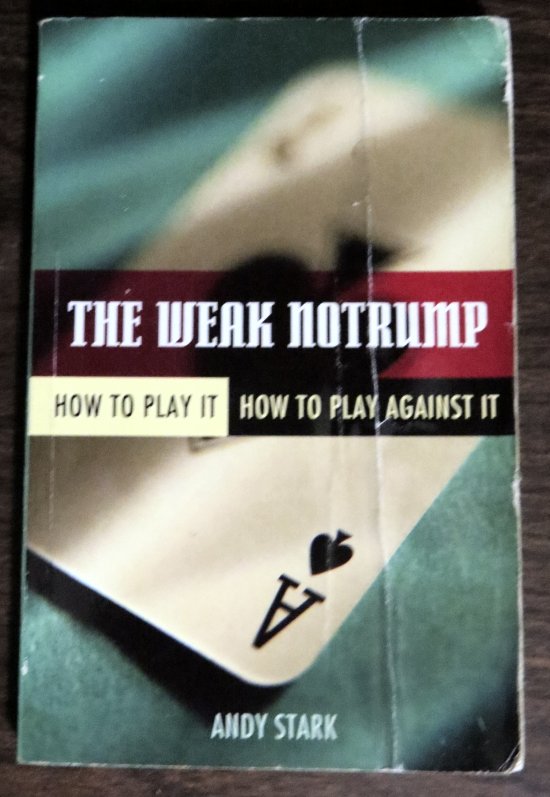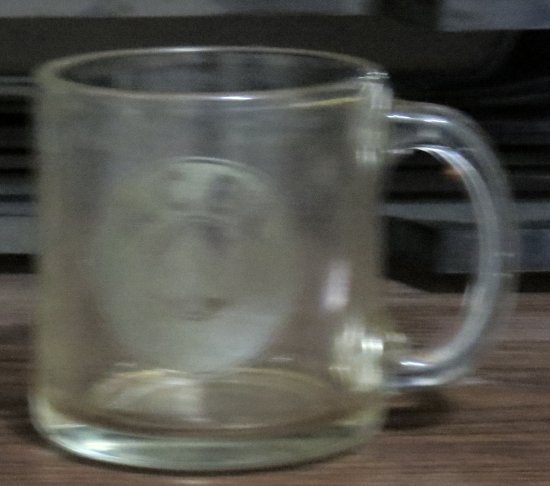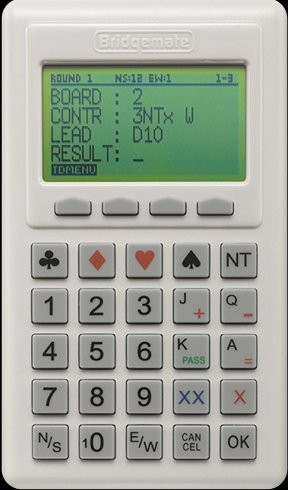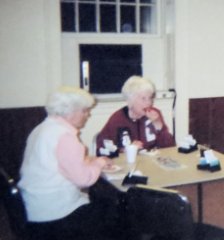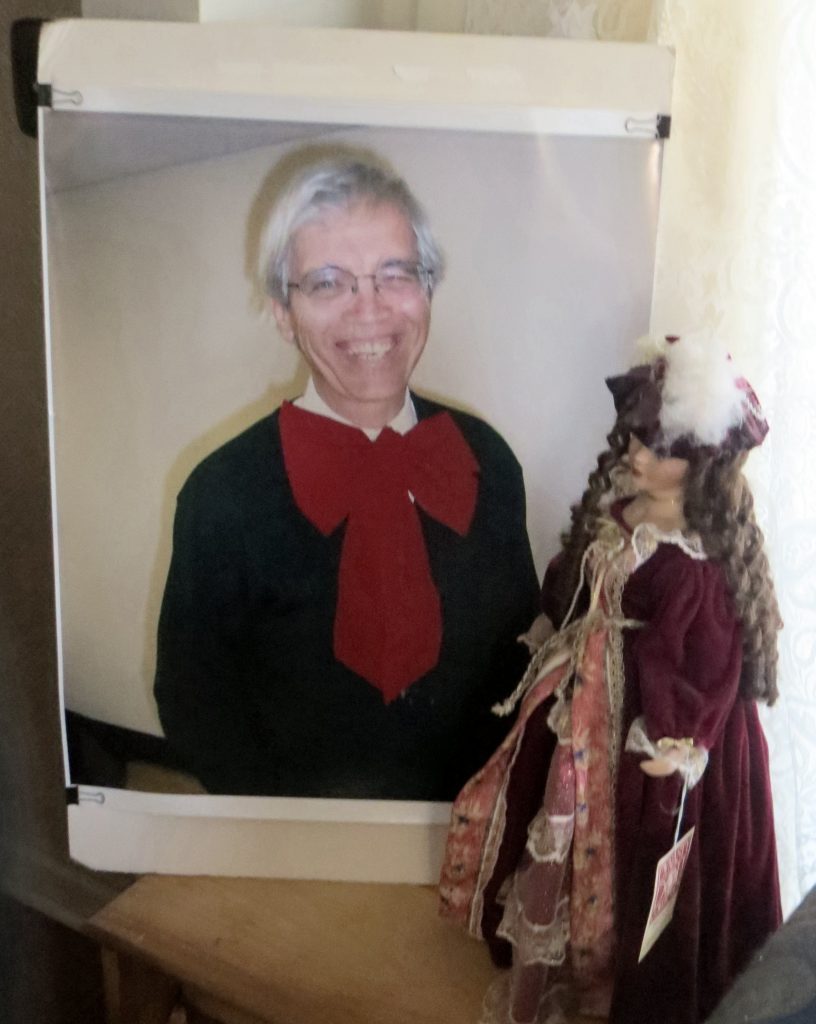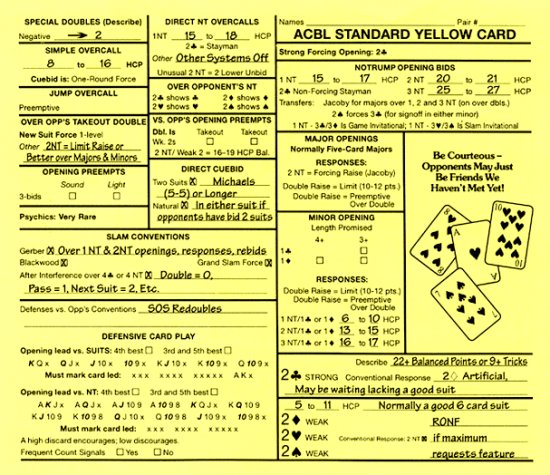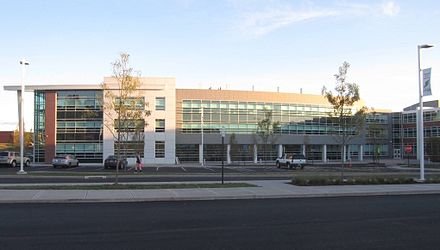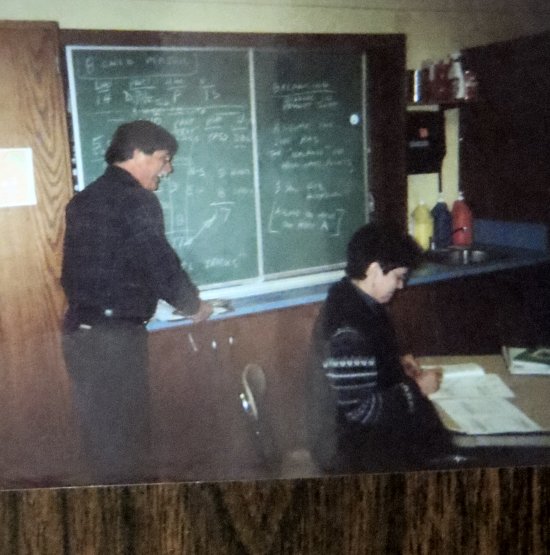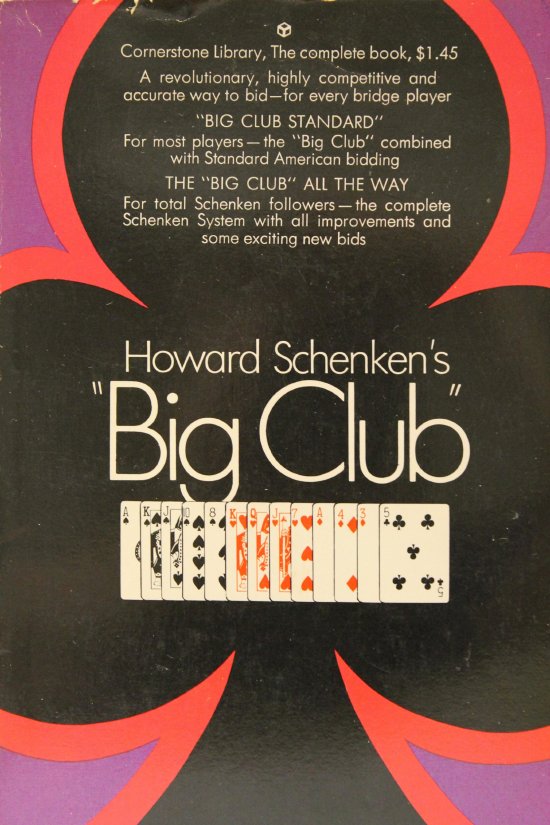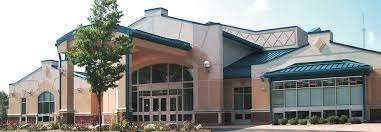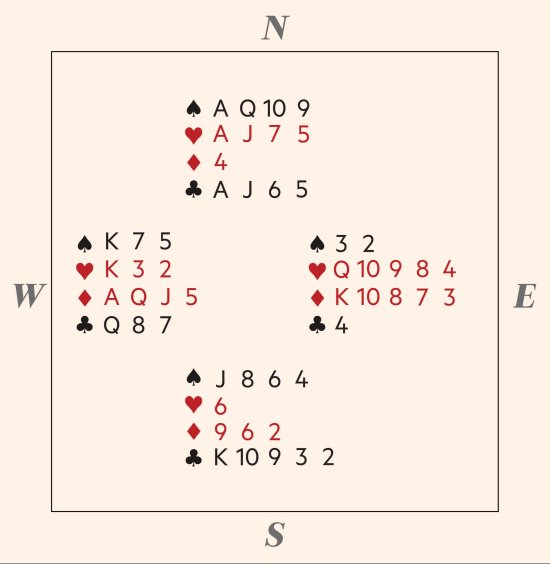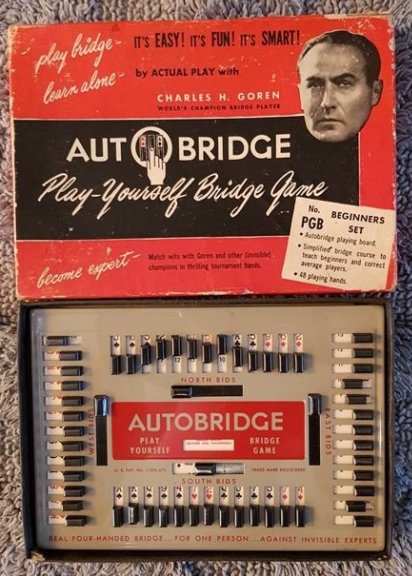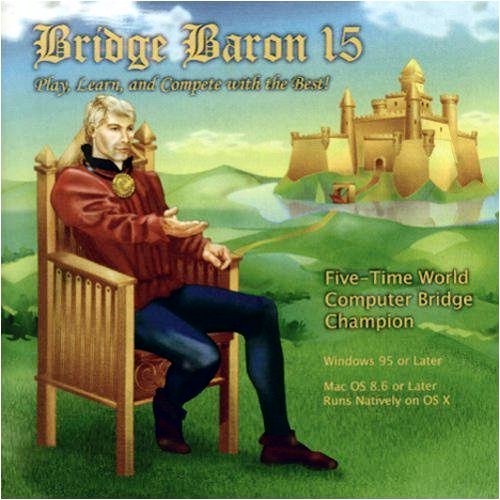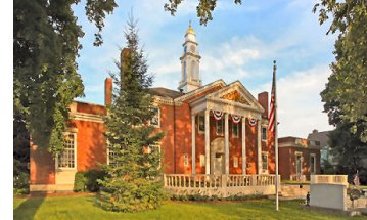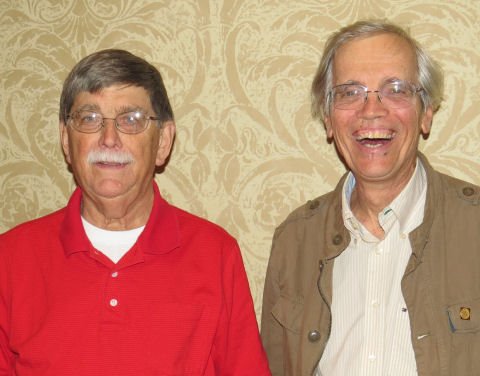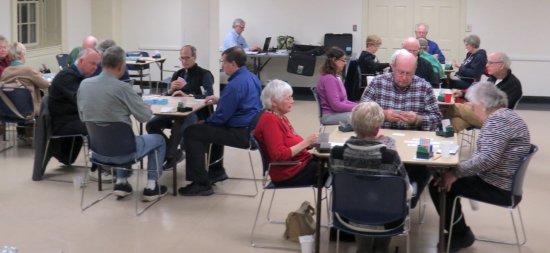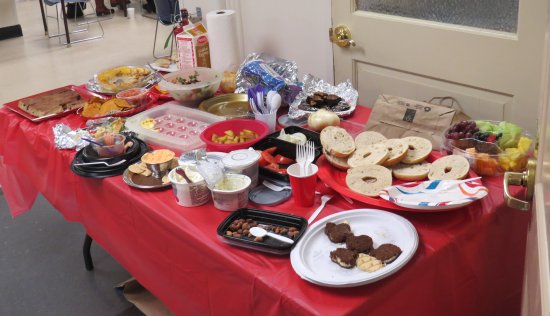Who was who at the SBC. Continue reading
I started playing in the Wednesday evening games at the Simsbury Bridge Club (SBC) in May of 2004. My experiences playing there in the early years and my recollections about the people who were my partner are recounted here. This entry describes other recollection about the club, including lists of the people who participated and my memories of them, if any.
If my recollection is correct, the club charged $5 for a membership in 2004. The membership was for life; there were no annual dues. The table fee each week was also $5 for members. Non-members were charged $6. I bought a membership the first evening. At first the director had access to the kitchen that was adjacent to the Youth Room. So, free tea and instant coffee were available.
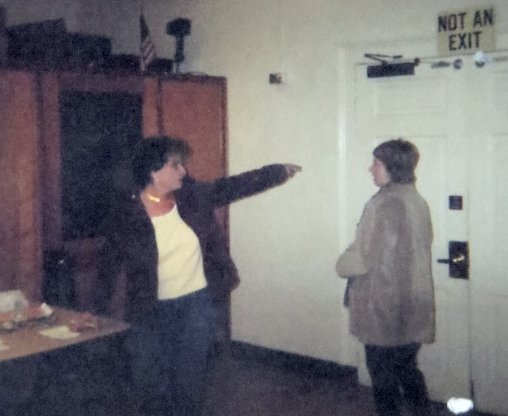
Paula Beauchamp was the owner/director of the club when I joined. I don’t know much about the history of the club before that. At one time there was a plaque honoring someone who had managed the club in the early nineties. I wish that I had taken a photo of it. The plaque was removed at some point before 2019.
Here are some of the people who played in 2004 and were never my partner in SBC games:
- Louise Alvord mostly played with Carol Schaper (SHAH pur) and Clara Horn. She played once or twice a month for several years. I do not know what happened to her. The Internet (in 2021) seems to think that she might still be living in Tarriffville. She was a former nun, but she did not resemble any of the nus that I knew. She no longer had any use for anything related to the Catholic Church. Carol suggested once that Louise might be interested in my book on the popes, Stupid Pope Tricks (posted here). Louise wanted no part of it. I discovered in December of 2021 that she was still playing in the unsanctioned game at Eno Hall.
- Carol and I played as partners a couple of times, but not at the SBC. She later played for several years with Maureen Denges. I liked Carol a lot, but she always claimed that she and Maureen were doing very badly whenever we were at the same table. Carol still lives in Simsbury, but she and Maureen stopped coming in 2019 or earlier.
- In 2004 and for a year or two afterwards Maureen played with Pat Matthew. Pat was an extremely slow player, but they were both pretty good. I nearly lost it one time when Pat started harping on me to play faster on one hand. Pat died. I think that Maureen is still living in Granby.
- Lila Englehart played a version of Schenken’s Big Club with Kay Hill. They also played at tournaments. I am pretty sure that Sue Rudd and I teamed up with them at least once. Lila was a large lady who drove a very large Buick SUV. She died at some point in the teens. Kay played more than Lila. For a while she partnered with Sue Rudd. She was still playing at the Hartford Bridge Club (HBC) when the pandemic caused it to close in March 2020. Kay was good at playing the cards, but her bidding was very old-school. She sometimes mentioned that she carried a gun. The story of my partnership with Sue is told here.
- Mel Hirsch sometimes came up from Florida to play with his brother Jerry. More details of the games that I played with Jerry are provided here. Mel was a good player. He and Jerry often finished first.
- I was surprised to see the names of Patty and Mark Howland. I did not remember them, but I played against Mark when he was assigned to play in an open game at the HBC in December 2021 with Jeanne Striefler. More about Jeanne can be read here.
- Jerry Hudson (female) played regularly at the SBC with Jeanne Striefler. I think that she died a few years after I started playing. I remember only that she was astounded when I took off my game face and put on my silly tie at the Christmas party. She said, “You’re like a whole different person.”
- Bob Nuckols‘ wife died the week before I started playing at the SBC. Everyone was talking about it. Bob returned to play with Bill Moody and a few other people including, for one game, me. He then played for a few years on a regular basis with Mary Lou Pech. I don’t remember too much about Bob except that his coffee mug had the black and gold colors of Purdue. He died in 2012. His obituary is here. Mary Lou was not a great player, but she was an awfully nice person. I remember that I made my first actual Endplay against her. She died in 2019. Here obituary is here.
- I would have liked to get to know Joanna Overbaugh better. She only showed up a few times a year to play with Dorothy Clark. She spent the rest of her time on around-the-world cruises! I played with Dorothy once when Joanna was cruising. I wrote about it here. Dorothy was also one of the judges in the Hartford Courant’s story contest that I entered in 1989. That event is described here.
- Helen Pawlowski was a very good player. I never played as her partner, but I got to know her pretty well when she took over as owner-director of the SBC. She was also the tournament manager for District 25 of the ACBL. In that role she found sites for our regional tournaments, negotiated the contracts, and dealt with the hotels in which we played. Soon after she took over the club in 2008 she began giving free classes before the games at Eno Hall. They were very popular. I always tried to show up early enough to listen to the lesson.
- Laurie Robbins played a few times at the SBC, always with Paul Pearson. I don’t recall any occasion on which they finished below first. I never played as her partner, but I often played against her with almost uniformly bad results. In 2021 she is a teacher and director at the HBC. Much more about Paul can be read here.
- David Rock is another exceptionally good player. He played in tournaments for several years with Sonja Smith. David was also very active in the administration of the district. He was vice-president of the New England Bridge Conference (NEBC) and was instrumental in setting up the smooth operation of the North American Bridge Championships held in Providence in 2014. David teamed up with Sally Kirtley to run the SBC in the teens. That period is described here. David moved to West Brookfield, MA. After that he only attended one game at the SBC.
- Sonja played with Jean Seale at the SBC for many years. After Jean moved to Colorado Sonja came to only a few games at the SBC, usually playing with her son Steve. Much more about Sonja is posted here.
- Shirley Schienman often played with her son, John Schienman. I never got to know Shirley—who always reminded me of Shirley Jones in her Partridge Family days—very well, but I had some good conversations with John. After John stopped coming to the SBC Shirley played with a variety of partners. Shirley died in 2017. Her obituary is here.
- The North-South seats at table #1 at the SBC were usually occupied by Ellen and Tony Tabell. When the subject of Moysian fits came up during one hand, they told me that they had known Sonny Moyse in New York. They moved to Exeter, NH, and, for a time ran a bridge club in the area. Tony died in 2020. His obituary is here.
- Claire Tanzer played almost every week with a few regular partners. I recall the details of only one conversation with her in December of 2009. It is recounted here.
- Don Verchick and Nancy Campbell played a strong club system that they called “Precision”. C.C Wei would not have recognized it. They never opened 1NT! Nancy played with various partners at the HBC through 2020.
- I was surprised to see that Mary Witt played at the SBC at least once with Tom Gerchman. Much more about Tom can be read here. Mary was the tournament coordinator for the Connecticut Bridge Association (CBA), which meant that she found sites, negotiated contracts, and brought the predealt boards to the sectional tournaments. Once she asked me to perform the last task for her. I was very flattered. Mary moved to Cary, NC. I have corresponded with her via email a few times.
- I don’t have any clear recollections of any of the following players whose names appeared on at least one results sheet in 2004.
- Robert and Ruby Cheah played together several times.
- Roger Evarts played once with Don Verchick.
- Dick and Joan Harris played together several times.
- I should remember Clara Horn, who played with a number of partners, but I don’t.
- I cannot place Maryann Joyce.
- Jean Marecki played with Lila Englehart.
- Alice Rowland played with Claire Tanzer.
- Ruth Schwartz played with Marylou Pech. Ruth played quite a bit, but I cannot picture her. I discovered in December of 2021 that she was still playing in the unsanctioned game at Eno Hall.
- Marcia and Norman Samuels played together.
- Martha Stout played with Claire Tanzer: I get Martha and Alice Rowland mixed up.
- Carl and Dorothy Suhre played together several times.
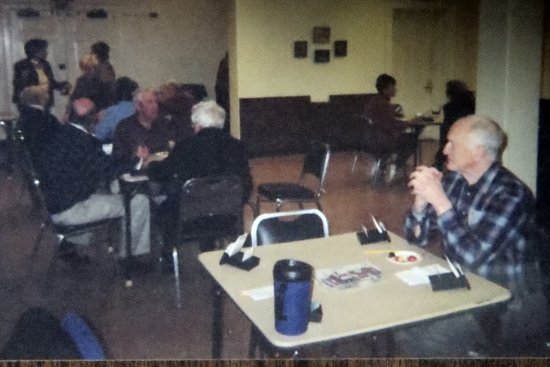
Below are listed people who began to play at the SBC in 2005. Paula was still the director.
- Fred Bird played regularly with Jean Little. They were married. After Fred died in 2011 Jean played at the SBC and the HBC with Max Horton and others. Jean died in 2018. Her obituary is here.
- Rita Bowlby played at the SBC only once. I don’t remember her. Her partner that evening was Dick Benedict, whom I remember very well. Those recollections are posted here.
- I am sure that I conversed with Jim McGarr several times, but I don’t remember any details. I can picture him pretty clearly. He died in 2015. His obituary is here.
- Jay and Luetta Gould owned a residence in Torrington, CT. They rarely came to the SBC, but I remember their visits were in different years. Jay also ran a game in the Berkshires in the summer. In 2021 they appear to live in Delray Beach, FL.
- Roger Holmes played with Dick Benedict for several weeks. Then they had a falling out. Dick once told me what they argued about, but I don’t remember.
- I was surprised to see Ausra Geaski’s name on the results sheets. I played as her partner in one pairs event at one tournament in 2014. I have played against her innumerable times. She was president of the New England Bridge Conference (NEBC) when I became the district’s webmaster in 2013, and she chaired the B’s Needs committee that helped revitalize the tournaments.
- I don’t have any clear recollections of any of the following players whose names appeared on at least one results sheet in 2005.
- Frank and Jean Catudal played together several times..
- I have no recollection of Ray and Sym Gallucci.
- Jack Gensheimer played with Jim McGarr once;
- Dick Kronk played with Bill Moody.
- Barbara Lynyak played with Dorothy Clark.
- Phyllis Martin also played with Dorothy Clark.
- Dennis McVickers played with Roger Evarts.
- Marcia Scarles played with Lila Englehart.
- Lou Urban played with Bill Moody.
- Rita Wolak played with Ausra Geaski.
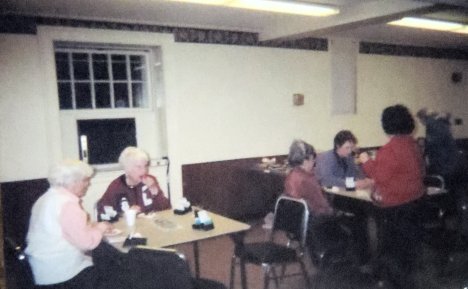
Below are listed people who began to play at the SBC in 2006. Paula was still the director.
- Betty Angel played once with Mary Witt. Betty is still an active member of the HBC. I don’t think that she ever played at the SBC again.
- Sue Gerchman was Tom’s mother. She played off-and-on with her son, who picked her up and drove her to the games. She also played once with her sister, whose first name was, I think, Benvenuta (Beni) Lostocco. I am pretty sure that they played in the same 299er game at the regional in Cromwell in which Dick Benedict and I played. A few years later, when I was playing with Tom, Sue died. I drove out to Avon for the wake. Some of Tom’s golfing friends were there, but I did not see any other bridge players. Beni died in 2014. Her obituary is here.
- I don’t remember the occasion, but on one evening in 2005 Stan Kerry played with Bob Tellar at the SBC. Their better halves, Sandy Sobel and Carol Tellar also played together. I think that Bob and Carol played together a few times at the SBC. They also played at the HBC, Carol more often than Bob. Stan is best known as the director and owner of the West Hartford Bridge Club, which directly competed with the HBC. I played there a couple of times, but I did not enjoy it much. In 2012 Stan and Sandy went on the same Larry Cohen Regional-at-Sea Cruise that my wife Sue and I took. My journal for that trips is posted here. Sandy died in 2017. Her obituary can be found here.
- Sally Kirtley made her debut at the SBC (at least to my knowledge) in 2005. We played together a few time, but not at the SBC. Sally became the director of the club in _____. She also directed in 2021, as was documented in considerable detail here.
- Judy Larkin played fairly regularly with Lisa Audolensky for a number of months. They were both new to the game and eager to learn how to play better. They invited Dick Benedict over to coach them. In exchange they agreed to cook supper for him. Dick readily agreedJudy has been playing again in the reborn SBC of 2021.
- I don’t have any clear recollections of any of the following players whose names appeared on at least one results sheet in 2006.
- Norman Hargett played one night with Ruth Schwartz; I don’t remember him.
- I have no memory of Matt Perry, who played with Roz Sternberg and Dick Benedict.
- Robert Wise played with Russ Elmore. Much more about Roz, Dick, and Russ can be read here.
Below are listed people who began to play at the SBC in 2007. Paula may have started as the director, but early in the year Helen Pawlowski took control. Helen continued the policy of guaranteeing a partner for everyone. Eventually she quietly abandoned the $5 charge for membership and raised the table fee to $6. Attendance reached ten tables on several occasions.
- Ida Coulter began playing with various partner, one of which was my wife Sue. Ida has been playing with Judy Larkin in the 2021 version of the club.
- Trudi Brown usually played with her husband, Lou Brown. I played with Lou in the afternoon Open Pairs game at a CBA sectional in Hamden. His partner from the morning went home at lunch time, and my partner stood me up. We finished roughly in the middle, but we might have done better if Lou had not revoked even after I warned him that he was not following suit. Lou was serving his two-year term as president of the CBA at the time. He treated Trudi brutally whenever she made a mistake at the table. I asked Trudi whether I should say something to him about behavior that violated the ACBL’s zero-tolerance1 guidelines. She asked me not to and indicated that it was like water off of a duck’s back to her. Lou told me in 2010 that he could not attend my Life Master party because he had to call numbers in a bingo game in which his mother played. Trudi made Life Master in 2012 in a knockout at the regional tournament in Cromwell, CT. I played on the opposing team. My description of the match is posted here. Lou and Trudi moved to Delray Beach, FL, shortly thereafter.
- Dan Finn played with Richard Finn, who was Dan’s brother (or maybe father) in one of the biggest games that we every had at the SBC. Dick and I played against the Finns at a card table that had been set up in the lobby. I also played with Dan at least twice, once at a tournament (described here) and once at the SBC.
- I don’t have any clear recollections of any of the following players whose names appeared on at least one results sheet in 2007.
- Dot Horton played with her husband Max. They were not great players, but they were very nice people. I remember that they took a river cruise in the south of France. They said that they had a great time. Dot once confided that when they started playing at Simsbury she was afraid of me. She died in 2015, but not from fright. Max continued to play with several other people at the SBC and the HBC. I almost got him to go to a tournament to play in a Pro-Am game once. Max died in 2021. I could not find an obituary.
- Karen Largay played with Sheila Gillin at the SBC pretty often until the Largays moved to the Cape. They also played with their husbands occasionally, but the ladies were more serious about the game. Dick Benedict and I teamed up with them for tournaments a few times. I also played as Karen’s partner once at the Senior Regional on Cape Cod. I warned her before the first hand that if the opponents had bid and raised a major suit that I might bid any weak hand with a five-card suit. She forgot and raised my bid. The opponents doubled and we got a bad score.
- I don’t know Steve Noble and his wife Chris Noble very well, but I have seen them at the HBC once in a while. I don’t know why they stopped coming to the SBC. I think that my wife Sue played with them in team events.
- Art and Marylin Noll played together at the SBC at least once. Marylin was a good player and a semi-regular at the HBC, but I have not seen her since the pandemic hit.
- Susan Pearson played with her husband Paul a few times.
- Jan Potts played with a few different partners. In the late teens she was a frequent partner for Jan Rosow.
- I had no recollection of Joan Brault playing at the SBC, but she attended several sessions. Her partner the first time was Beth Rotko, whom I do not remember at all. I played with Joan fairly often at the HBC. Those games are described here.
- Arline Small played frequently at the HBC. She occasionally played with her husband Stuart at the SBC.
- I don’t have any clear recollections of any of the following players whose names appeared on at least one results sheet in 2007.
- Janice Boyko played with Ida.
- Lillian Clark finished first out of ten pairs the evening that she played with Maryann Maikowski. They also finished at the top on at least one other occasion, but I don’t remember them.
- Bill and Lenore Davis played together a few times.
- Mary Fanette played with Helen once.
- Art Marglies and Hannah Marglies played at least once, but don’t remember them.
- Gladys McFetridge played with Dorothy Clark several times.
- Margaret Milch played with Ida.
- Rosa Shields played with Roz.
- It seems like I should remember Donna Summer, but when I try to visualize her, all that I can see is the disco singer.
- Barbara Steckler and June Rosenblatt don’t ring any bells either.
- Elena Thompson played once with Carol Soucy.
- Lisa Woods played once with Ida Coulter.
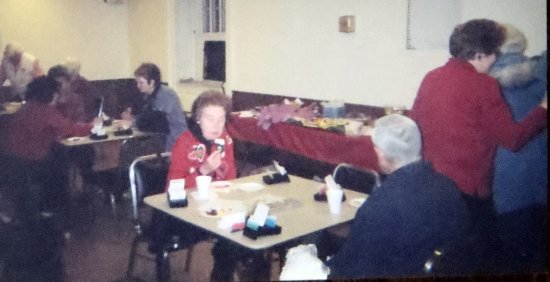
Helen’s second year of directing was 2008. Listed below are some of the new players.
- Michael Dworetsky played with Dan Finn and then with his wife Ellen. I played at many tournaments with Michael and as often as possible at the HBC. Our exploits together are assembled here.
- Linda Kessleman played with Margie Garillli. Later Linda played pretty often with Mary Witt, Dick Benedict, and a few other people. I think that she was a real estate agent. Margie ran some games in the area and filled in as a director at the SBC. She played pretty often with Donna Lyons before the pandemic.
- Sandy Macri played with someone else first, but eventually she teamed up with Karen Sterrett. I liked both of them a lot. I had to like Karen; she was a fellow Wolverine. They are both active members of the HBC.
- Jeff Morris and Ron Saxon were both doctors. I went to Ron once when I had a build-up of wax in my ears. He was friends with Michael Dworetsky. Jeff sometimes played with his wife, who was very intense.
- Jeff Oakes played with Sue Rudd. I don’t remember Jeff. Details about my long and continuing relationship with Sue are posted here.
- Alden Stock played with Michael Dworetsky. He later played at the SBC with his wife Reba.
- Louise Sunter played with Helen and Donna Lyons. I don’t remember Louise at all, but Donna is one of my favorite people in the world. I played with her a few times at the HBC and in a few tournaments. The details can be read here.
- I don’t have any clear recollections of any of the following players whose names appeared on at least one results sheet in 2008.
- Mark Johnson played once with Helen.
- Susan Lewis played with Shirley.
- Howard Mark and Sheila Mark played together, but just once.
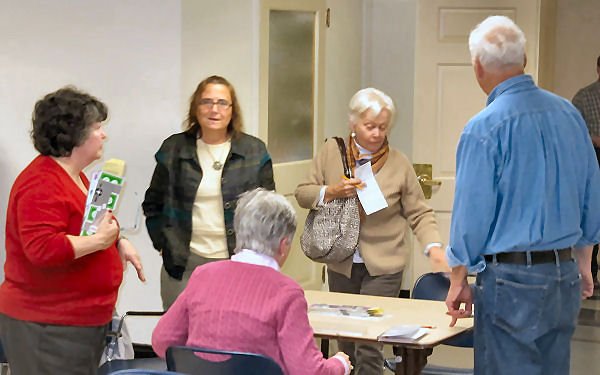
Helen continued as owner-director in 2009. Listed below are some of the players who first played at the SBC that year.
- Judy Goff played with Louise Alvord. Judy later became one of my wife Sue’s regular teammates. I think that they were partners at one or two tournaments.
- I can hardly believe that Len Helfgott played at the SBC one night with Roz. He is a very good player. I played against him on Tuesday nights at the HBC a few times. I also recognized his name from reading a question that he submitted to the column in the Bridge Bulletin written by great Eric Kokish. On one hand that I played against Len I used “restricted choice”2 to determine which way to finesse. It worked, and Len remarked that bridge players know the play, but no one else would believe it.
- I definitely remember Anne and Paul Melvin, but I don’t have any stories about them.
- Barbara Perez played with her sister, Donna Lyons, a few times. Barbara lives in Mexico, but she asked me to keep her apprised of developments in bridge in the area.
- Jan Rosow played with Joan Rusconi in their debut at the SBC. Jan became a Life Master in 2014. In 2021 she came to the club about once per month. Jan is also very active in the CBA. I don’t remember Joan playing at all in subsequent years, but I often saw her at the HBC.
- I don’t have any clear recollections of any of the following players whose names appeared on at least one results sheet in 2009.
- Beverly Lapioli and Sharon Smith played together one evening.
- Peter Milliken played twice with Helen and once with a few others.
- Doris Rothe played with Donna Lyons.
- Mike Schwefel played with Jeff Morris.
- Helene Wade and Lil Nolan played together.
Helen was still director in 2010. Listed below are some of the players who first played at the SBC that year.
- Tim Largay played with his wife Karen. I think that he was more interested in golf than bridge.
- Vivian Leshin played with Nancy Campbell. Vivian was a regular in the Tuesday night game at the HBC. She was the first person who warned me there that “Getting old is not for sissies.” I did not remember her playing in Simsbury. I was in attendance when she earned Silver Life Master at the Senior Regional in Hyannis. Her partner for that event was someone she had just met at the tournament’s partnership desk. I think that that was Vivian’s last tournament.
- I don’t have any clear recollections of any of the following players whose names appeared on at least one results sheet in 2010.
- Tina Cheffer played with Judy Goff.
- Caroline Collins played with Ruth Schwartz.
- Connie Fictner played with Louise Lapioli.
- Kay Yaznac played with Tina Cheffer. I don’t remember them.
I have lost the records for 2011 and 2012. The lists continue with 2013 here.
1. In 1998 the ACBL instituted a policy designed to make for a friendlier and more pleasant environment at all levels of duplicate play. It is posted here.
2. The principle of restricted choice is explained pretty well in the Wikipedia article that is posted here.


